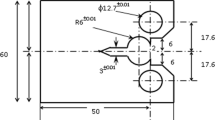This article examines two of the six most common types of fracture of steel and steel structural elements: brittle fracture by cleavage and ductile fracture. The corresponding micromechanisms of fracture and the characteristic relief that is left on the fracture surface are also discussed. The most important and most interesting features of the behavior that the steel and the structural elements exhibit during service and fracture are noted. Among the topics here are a mechanical criterion for brittle fracture, rapid catastrophic ductile fracture, the participation of cleavage in the formation of lamellar cracks, and preventing the delayed fracture of high-strength bolts by altering the chemical composition of the steel.






Similar content being viewed by others
References
H. Leibowitz (ed.), Fracture [Russian translation], Mir, Moscow (1973–1977).
Mechanics: Scientific Advances Abroad. Iss. 17: Fracture Mechanics. The Fracture of Materials [in Russian], Mir, Moscow (1979).
Ibid., Iss. 20.
J. F. Knott, Fundamentals of Fracture Mechanics [Russian translation], Mir, Moscow (1980).
M. A. Shtremel (ed.), Atomic Mechanism of Fracture [Russian translation], Metallurgiya, Moscow (1963).
P. B. Mikhailov-Mikheev, Thermal Embrittlement of Steel [in Russian], Mashgiz, Leningrad (1956).
V. M. Goritskii, Thermal Embrittlement of Steels [in Russian], Metallurgizdat, Moscow (2007).
P. D. Odesskii and I. I. Vedyakov, Impact Toughness of Steels for Metal Structures [in Russian], Intermet Engineering, Moscow (2003).
L. I. Gladshtein, V. M. Goritskii, A. I. Kovalev, and V. I. Sarak, “Effect of grain size on the size of the facets in transcrystalline cleavage,” Probl. Prochn., No. 3, 60–62 (1979).
V. M. Goritskii and D. P. Khromov, “Structure and quantitative fractographic analysis of brittle fractures of low-carbon and low-alloy steels,” Fiz. Met. Metalloved., 55, No. 6, 1169–1178 (1983).
V. M. Goritskii and D. P. Khromov, “Effect of test temperature on fractographic characteristics of the brittle fracture of low-carbon and low-alloy steels,” ibid., 58, No. 1, 154–163 (1984).
L. A. Kopelman, Resistance of Welded Joints to Brittle Fracture [in Russian], Mashinostroenie, Moscow (1978).
L. I. Gladshtein and N. P. Larionova, “Effect of ferrite grain size on characteristics of the deformation and fracture of structural steel,” Probl. Prochn., No. 7, 68–75 (1982).
L. I. Gladshtein, N. P. Larionova, and R. A. Milievskii, “On evaluating the cold resistance of steel based on results from the testing of specimens with an acute triangular notch,” PGS, No. 2, 26–28 (2008).
N. A. Makhutov, L. I. Gladstein, and Yu. M. Grachev, “Fracture of the thin-walled shell models under internal pressure loading,” Probl. Prochn., No. 2, 3–9 (1976).
Author information
Authors and Affiliations
Corresponding author
Additional information
Translated from Metallurg, No. 2, pp. 61–66, February, 2011.
Rights and permissions
About this article
Cite this article
Gladshtein, L.I. Fracture of the materials and elements of steel structures. Metallurgist 55, 123–130 (2011). https://doi.org/10.1007/s11015-011-9401-y
Received:
Published:
Issue Date:
DOI: https://doi.org/10.1007/s11015-011-9401-y
Key words
- ductile and brittle fracture
- strength
- ductility
- toughness
- anisotropy
- constant
- variable
- and local stress
- elastic
- plastic
- uniform
- and concentrated strain
- stress concentration
- strain concentration
- static
- dynamic
- variable
- and cyclic loads
- microstructure
- metallographic and crystallographic texture
- crystalline lattice
- defect
- dislocation
- weldability
- carbon equivalent
- crack




